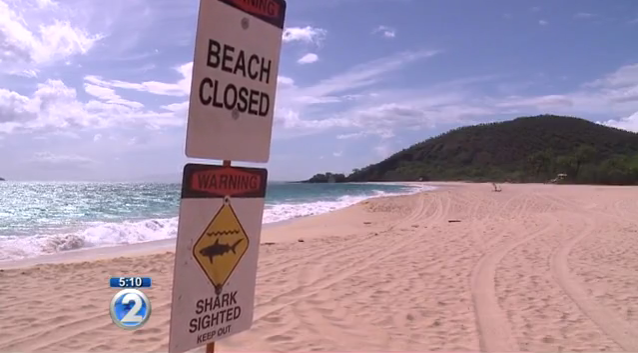Public warned of spike in shark attacks in October
 Image courtesy of KHON2.
Image courtesy of KHON2.Shark warning signs were posted Tuesday 10 October 2017 at Davidson’s Beach, near Kekaha on the southwest side of Kaua‘i. The signs are a reminder to surfers and ocean lovers to be cautious and aware during October, which is known to have a higher number of shark attacks.
“If you look at 40 years of data, there is a spike in October that is statistically higher than the rest of the year,” said Kim Holland, shark expert at the Hawai‘i Institute of Marine Biology (HIMB).
KHON2 asked Holland why we see more shark attacks in October. “We really don’t know the answer, because our research indicates that the highest number of sharks, tiger sharks in Hawai‘i, is actually in winter, not in the fall,” Holland said. He says large sharks are in coastal Hawaiian waters all the time and “there’s no direct link between the number of sharks around Hawai‘i’s waters and the number of shark attacks.”
There’s a Hawaiian saying that “pua ka wiliwili nanahu ka manō,” or “when the wiliwili tree flowers, the shark bites.” Wiliwili trees bloom in late summer and early fall, and the state Department of Land and Natural Resources points to the saying in public warnings to beachgoers.
Tiger shark birth season stretches from September to early November, and past studies by the University of Hawai‘i have found that about a quarter of mature female tiger sharks in the Northwestern Hawaiian Islands migrate to the main Hawaiian islands in the fall. Pregnant females of other shark species effectively starve themselves to nourish their pups, Carl Meyer, assistant researcher at the HIMB, wrote in 2015. And, while scientists don’t know whether this occurs in tiger sharks as well, it’s possible that the increased number of sharks and a population of hungry mother sharks could lead to more attacks in the fall.
Read more about it and watch the video report at KHON2; read about it in the Maui News and the Honolulu Star-Advertiser (subscription required).



